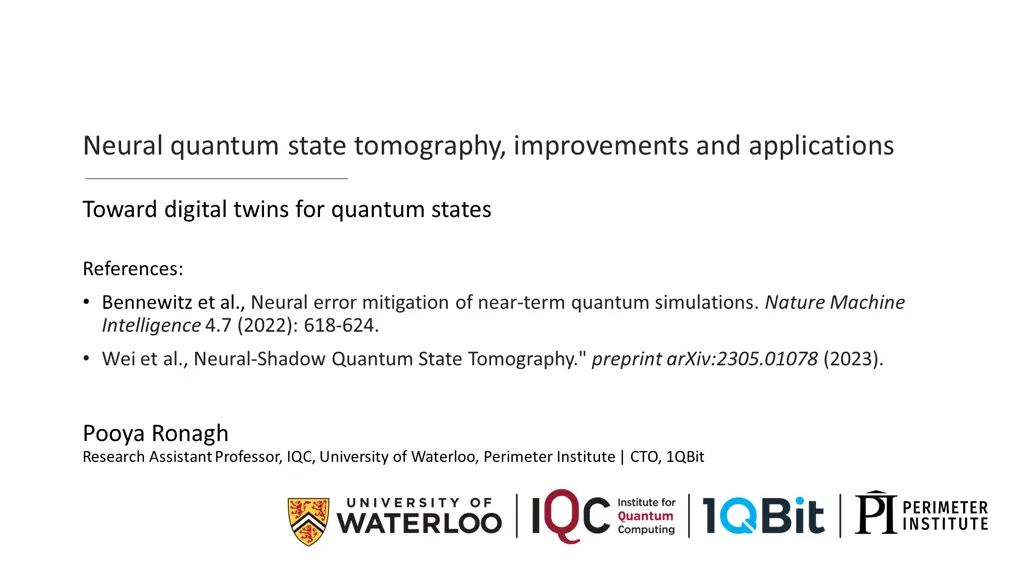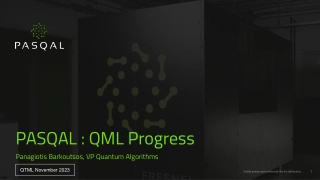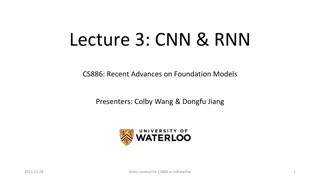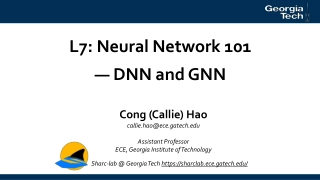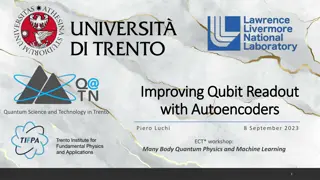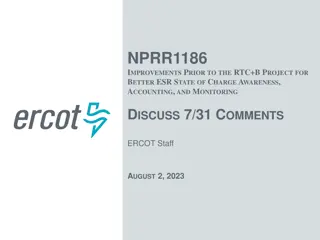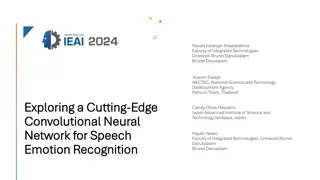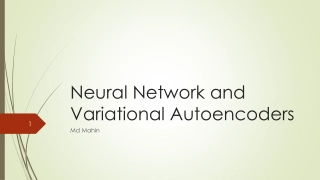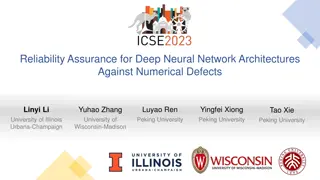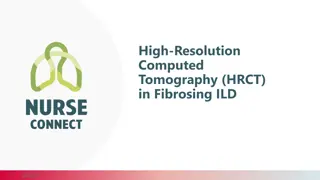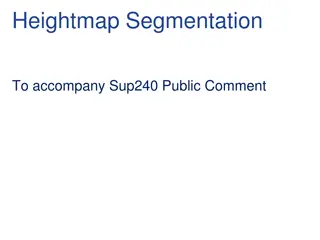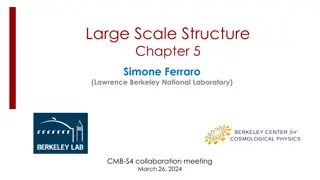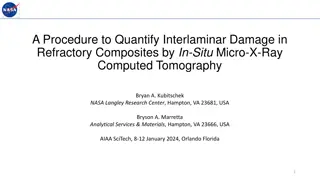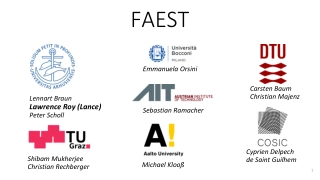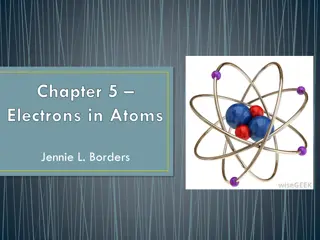Neural quantum state tomography, improvements and applications
Advancements and potential applications of neural quantum state tomography, aiming to reduce the exponential classical memory required for expressing quantum states. It discusses the benefits of using machine learning techniques to process and analyze quantum data, such as cleaning up states, manipulating them, and estimating observables. It also highlights the importance of efficient and standardized methods to make quantum experiment results accessible to the wider community.
Download Presentation
Please find below an Image/Link to download the presentation.
The content on the website is provided AS IS for your information and personal use only. It may not be sold, licensed, or shared on other websites without obtaining consent from the author. Download presentation by click this link. If you encounter any issues during the download, it is possible that the publisher has removed the file from their server.
- Neural quantum state tomography
- improvements
- applications
- quantum data
- machine learning
- quantum experiments
- classical cloning
- quantum computing
- data accessibility
Presentation Transcript
Neural quantum state tomography, improvements and applications Toward digital twins for quantum states References: Bennewitz et al., Neural error mitigation of near-term quantum simulations. Nature Machine Intelligence 4.7 (2022): 618-624. Wei et al., Neural-Shadow Quantum State Tomography." preprint arXiv:2305.01078 (2023). Pooya Ronagh Research Assistant Professor, IQC, University of Waterloo, Perimeter Institute | CTO, 1QBit
Motivation 1Big quantum data! Quantum experiments are creating increasing amount of experimental data. The amount of classical memory required to express quantum states grow exponentially. We ll have a huge amount of data to post-process, analyze, and collect statistics from. BUT! Quantum states are difficult to express classically? Goal: Bend the curve of exponential classical memory required for expressing quantum states. ML has been very successful in doing the same for classical big data: turning big data into AI. Let s do the same to quantum data to achieve operational access to quantum data instead of storing exponentially large tables and sweeping over them in every query. Applications: Cleaning up the state! Imposing purity, symmetries, etc. of the target state. Manipulating the state: decreasing its energy further variationally. Observable estimation at the cost of classical inference from a model, rather than sweeping over exponentially large raw data. 2 Institute for Quantum Computing and Department of Physics & Astronomy, University of Waterloo | Perimeter Institute Quantum Intelligence Lab | 1QBit
Motivation 2Classical cloning is cheap! Unlike quantum states, classical memory is easy to replicate. Calculating overlaps of digital twins is much easier than performing swap operations: Fidelity estimation, Entanglement entropy estimation. Applications: Verification of quantum computation, Cross platform benchmarks. 3 Institute for Quantum Computing and Department of Physics & Astronomy, University of Waterloo | Perimeter Institute Quantum Intelligence Lab | 1QBit
Motivation 3Quantum computing is expensive! Quantum experiments are expensive to do, repeat, and make widely accessible. Fault-tolerant quantum computers will be large sophisticated facilities. At 1 USD / second / 1000 qubits, Shor s factorization will cost +500M. Need for efficient and standardized ways to make the results of experiments available to the community. CERN data centre, wikimedia.org 4 Institute for Quantum Computing and Department of Physics & Astronomy, University of Waterloo | Perimeter Institute Quantum Intelligence Lab | 1QBit
Motivation 3Quantum computing is expensive! 5 Institute for Quantum Computing and Department of Physics & Astronomy, University of Waterloo | Perimeter Institute Quantum Intelligence Lab | 1QBit
Neural-network quantum state tomography Neural quantum state tomography aims at reconstructing a quantum state using a generative model. As a standalone algorithm, it is compared to Monte-Carlo algorithms for ground state preparation. As a quantum state tomography method, it is studied from the tomographic/information theoretic aspect (i.e., how well is the reconstruction, at what cost). Our goal: Turn NNQST into the quantum information scientist s daily R&D tools. This talk: (a) Applications in ground state preparation, (b) Improvements using the classical shadow formalism. 6 Institute for Quantum Computing and Department of Physics & Astronomy, University of Waterloo | Perimeter Institute Quantum Intelligence Lab | 1QBit
Machine learning introduction Generative models historically have emerged in ML from image processing tasks. A different collection of deep generative models have been developed motivated by natural language processing (NLP) tasks. Auto-regressive models: ? ? = ?? ???1, ,?? 1), Two common architectures in NLP: Recurrent neural networks Transformers RNNs: Precursor to the more powerful SOTA transformers Encoder-decoder mechanism Sequence to sequence architecture 7 Institute for Quantum Computing and Department of Physics & Astronomy, University of Waterloo | Perimeter Institute Quantum Intelligence Lab | 1QBit
Attention As opposed to RNNs, all hidden states are available at the same time. Attention was then incorporated in a breakthrough model called the Transformer, which became a critical component of Dall-E, ChatGPT, Bard, etc. Perhaps better parametrized models for quantum data should be developed . 8 Institute for Quantum Computing and Department of Physics & Astronomy, University of Waterloo | Perimeter Institute Quantum Intelligence Lab | 1QBit
Transformers A model architecture eschewing recurrence and instead relying entirely on an attention mechanism to draw global dependencies between input and output. [Vaswani 17] Avoid relying on temporal dependence of elements to each other. Decide how important each element is with respect to all the other elements in the original sequence. The architecture includes an encoder and a decoder. Relies on two mechanism for attention: A self-attention mechanism used in the encoder. A cross-attention mechanism used in the decoder. The positional encoding can be used to keep track of the order in a sequence if needed (e.g., in machine translation). https://arxiv.org/pdf/1706.03762.pdf 9 Institute for Quantum Computing and Department of Physics & Astronomy, University of Waterloo | Perimeter Institute Quantum Intelligence Lab | 1QBit
Queries, keys, and values Three types of vectors as learnable parameters: Queries: ? = ??? Keys: ? = ??? Values: ? = ??? Keys and queries are of same dimension, but values may be of arbitrary dimension. We ignore this detail and simply write ?,?,? ? ?. The attention weights are then generated via ? = ???? ??? max ?(???). The output state is then generated using A = (?) and ?: ? = ?? ? ?. 10 Institute for Quantum Computing and Department of Physics & Astronomy, University of Waterloo | Perimeter Institute Quantum Intelligence Lab | 1QBit
Neural error mitigation Error mitigation: post-processing step to alleviate errors affecting the output of a noisy quantum device. Many different creative ways to approach error mitigation Average the results of circuits from a quasi-probability distribution (Temme et al., 2017) Learn a scalable noise model by comparing noisy and noise-free circuits (Czarnik et al. 2020) Why stop there? We can clean up neural quantum states in other ways too (e.g., re-enforcing symmetries). Advantages: Generally, does not require significant additional quantum resources; Relevant for current and near-term quantum processors. Schematics by E Bennewitz 11 Institute for Quantum Computing and Department of Physics & Astronomy, University of Waterloo | Perimeter Institute Quantum Intelligence Lab | 1QBit
Neural error mitigation 12 Institute for Quantum Computing and Department of Physics & Astronomy, University of Waterloo | Perimeter Institute Quantum Intelligence Lab | 1QBit
Neural error mitigation How do we represent ??(?) and ?? = ??(?) ? Exact Approximate ?? (?) (?) ?? ??(?) ?(?) | = |? | ? = |? ? ? ? Represent the probability amplitudes via the auto-regressive expansion ??? = ?=0 sample from ??(?). Interpret the complex output of a Transformer as: ln ?(?) = ? ??? + ln ?? Real part: log probability 1 2ln ??? , and Imaginary part: phase ??? . Optimize ? according to some cost function. ?(??|?<?) and , ?(? ) ?(?). To compute observables of interest ? = ???? ????, where ????= ? ??? 13 Institute for Quantum Computing and Department of Physics & Astronomy, University of Waterloo | Perimeter Institute Quantum Intelligence Lab | 1QBit
Neural error mitigation Step 1 (neural quantum state tomography): Optimize ? with SGD according to cross entropy ??= ????? ln(??(?)) ? {0,1}? for which we estimate ????using measurement samples, ? = (?1,0 , ?2,1 , ?3,1 , }. 1 ? ?? ln ???? . ?? ?? Step 2 (variational Monte-Carlo): Optimize ? to obtain lower expected energy min??= min ? ? ? according to ?? 1 ?? ? ??= ??? ????? ???? ?? , ? ?=1 ?(? ) ?(??). where ?????? = ? ???? 14 Institute for Quantum Computing and Department of Physics & Astronomy, University of Waterloo | Perimeter Institute Quantum Intelligence Lab | 1QBit
Quantum chemistry (Example 1) Electronic structure Hamiltonian of LiH. Jordan-Wigner transformation: convert to a qubit-based Hamiltonian. VQE ansatz: the hardware-efficient ansatz of Kandala, et al. Nature (2017). 15 Institute for Quantum Computing and Department of Physics & Astronomy, University of Waterloo | Perimeter Institute Quantum Intelligence Lab | 1QBit
Quantum chemistry (Example 1) Statistics of each computational basis state at bond length 1.4. Trick: maximize the L1 norm ? 0,1?| ?(?)|. 16 Institute for Quantum Computing and Department of Physics & Astronomy, University of Waterloo | Perimeter Institute Quantum Intelligence Lab | 1QBit
Lattice gauge theory (Example 2) Simulation of Lattice Schwinger model (an abelian lattice gauge theory, toy model for quantum electrodynamics in 1D) following the ansatz of Kokail, et al. Nature 569.7756 (2019). Bare electron mass term Creation and annihilation of electron--positron pairs Coupling to electric field The goal is to study a phase transition at about m= -0.7. 17 Institute for Quantum Computing and Department of Physics & Astronomy, University of Waterloo | Perimeter Institute Quantum Intelligence Lab | 1QBit
Lattice gauge theory (Example 2) 18 Institute for Quantum Computing and Department of Physics & Astronomy, University of Waterloo | Perimeter Institute Quantum Intelligence Lab | 1QBit
Comparison of NEM and standalone VMC 19 Institute for Quantum Computing and Department of Physics & Astronomy, University of Waterloo | Perimeter Institute Quantum Intelligence Lab | 1QBit
Learning the phases Perform random Clifford tails ??and measure bit strings |?? . Collect stabilizer states: ?? = ?? Average effect of the Clifford twirling is a depolarizing noise channel with strength 2?+ 1 1. Classical shadows: ??= 1(|?? ??|). Target state: | | = ?[ 1(|?? ??|)]. New loss: |?? . ? ? 1 1 ?? ???? = 1 1 2?1 1 1 2 1 ?? ? ? ???? ? ? ? 20 Institute for Quantum Computing and Department of Physics & Astronomy, University of Waterloo | Perimeter Institute Quantum Intelligence Lab | 1QBit
Quantum material: Example 3 1D anti-ferromagnetic Heisenberg model two Trotter steps away from | . ? 1 ? = ????+1+ ????+1+ ????+1 ?=1 21 Institute for Quantum Computing and Department of Physics & Astronomy, University of Waterloo | Perimeter Institute Quantum Intelligence Lab | 1QBit
Robustness to noise Following D. E. Koh and S. Grewal, Quantum 6, 776 (2022): Scaled gradient: And the shifted loss function is 22 Institute for Quantum Computing and Department of Physics & Astronomy, University of Waterloo | Perimeter Institute Quantum Intelligence Lab | 1QBit
Comparison with direct shadow estimations Better generalization for non-local observations (e.g., long Pauli strings) in a QCD example: 23 Institute for Quantum Computing and Department of Physics & Astronomy, University of Waterloo | Perimeter Institute Quantum Intelligence Lab | 1QBit
Concluding remarks Quantum experiments are very difficult to perform: Expensive and long experimental cycles. No cloning has made us not think hard enough how to Capture the experiments in re-usable fashion; Make the results of the experiment available to the community. How can NSQST be better than just the list of measurements from a tomography scheme? The same way GPT is much more useful than the entire corpus of text on the web. NSQST provides an operational representation of the quantum state for Other processes and applications For interfacing between devices The neural network representation is a digital twin of the quantum state: This shifts the value from quantum experiments to quantum data. Inference from the digital twin is much cheaper than rerunning quantum experiments. The digital twin is much more malleable and easier to interface with than the quantum computer. 24 Institute for Quantum Computing and Department of Physics & Astronomy, University of Waterloo | Perimeter Institute Quantum Intelligence Lab | 1QBit
Team Elizabeth E Bennewitz University of Maryland Florian Hopfmueller Nord Quantique Juan F Carrasquilla Vector Institute, U Waterloo Bohdan Kulchytskyy 1QBit Neural error mitigation of near-term quantum simulations. Nature Machine Intelligence 4.7 (2022): 618- 624. Neural-Shadow Quantum State Tomography." preprint arXiv:2305.01078 (2023). Victor Wei IQC, UW Christine A. Muschik IQC, UW, PI W. A. Coish McGill 25
Open positions: Postdoc 1 (neural quantum states) Postdoc 2 (quantum algorithms) PhD (quantum algorithms) Pooya Ronagh pooya.ronagh@uwaterloo.ca 26
